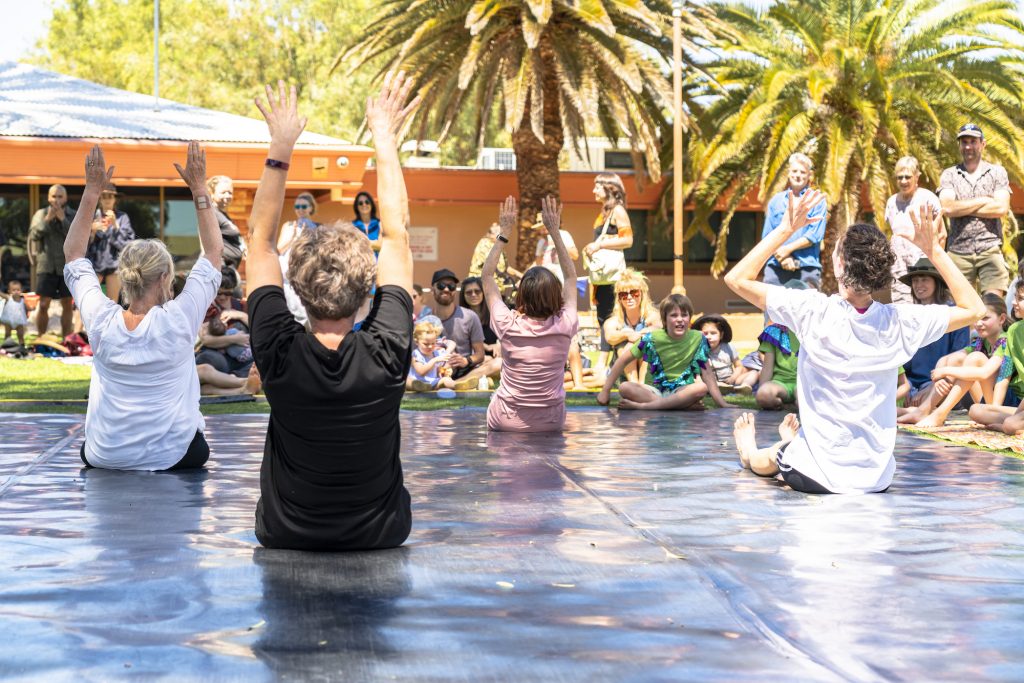Annual Review stories Community stories: 10 November 2022
On Arrernte Country
You’ve heard of the connecting and positive power of dance, right? Well, GUTS Dance Central Australia knows all about it – and knows it works. They saw an opportunity to use dance as a way to celebrate local diverse cultures in Alice Springs and, as the only contemporary dance organisation within a 1,500 km radius, this was squarely in their domain!
‘Alice’ as it’s known colloquially, is home to 25,000 residents, however there are no other towns or cities closer than 400 km away. Social cohesion can be difficult here, with divisions in the community “primarily based on race and historical disadvantage fuelled by a lack of understanding and exchange”. GUTS believed that they could address this and break down negative misconceptions through better visibility of minority populations through the art of dance.
“We see dance as a universal language that crosses cultural boundaries. People who are part of these dance groups are often newly arrived to Australia and they find cultural connection within the dance groups, or are First Nations Australian’s on whose land we live, and whose culture needs to be seen, respected and learned about.”
For much of the year in Alice, it’s too hot to have outdoor activities during the day, and there was only one significant event – Harmony Day – that brought together cultures in Alice.
They thought it was about time for another offering and started planning. As part of SPRING.LOADED.DANCE, GUTS’ inaugural contemporary dance festival, they would deliver a Community Dance Day (CDD), during which social and cultural dance groups could showcase their dancing, and audiences could join in!
Using a $9,800 Strengthening Rural Communities grant funded by FRRR, the festival team identified local groups to be involved, liaised with participants, undertook the planning for setup and packdown of the site and marketed the event. The CDD event took place on the Council Chamber Lawns in the CBD of Mparntwe/Alice Springs. It included Tinkerbee Arrernte Dancers, who got to showcase their incredibly important dances and gain experience in performing for audiences. The GUTS 50+ dance group ‘Chance to Dance’ had their first public performance – ”a wonderful stepping stone for building their confidence to perhaps continue to work towards more small performances in the future.“ There were Balinese and Nepalese dancers, kids dance offerings, Afo Afro Dance Group and Alice Swing.
The GUTS Brave Bodies group also performed a short piece by emerging Arrernte / Yankunytjatjara dance maker Toni Lord, created out of her grandmother’s stories. Most of the young women in the group have First Nations heritage, however for many this was their first time performing a contemporary Aboriginal dance piece.
Each dance group was paid for their time, showing that the organisers truly understand the value of each distinct offering and practice.
With performances from 50 dancers, and attendance by 230 community members over 2.5 hours, GUTS is confident that a broad cross section of the community was able to watch and participate, and benefit from exposure to the wonderful world of cultural dance.
Co-artistic Director, Madeleine Krenek, said they will endeavour to run CDD every year, regardless of whether the SPRING.LOADED.DANCE event continues.
“While there were many different offerings throughout the broader festival, CDD was perhaps the most celebratory, inclusive and fun event we put together.
“There was a wonderful amount of participation from the audience and the general energy was proud and supportive.
“Through GUTS’ work with young people in the community, we know that when dance is employed as a vehicle for empowerment and engagement, it is celebrated by a diverse and numerous portion of our population.
“Often, we find that people have never been exposed to dance before and once they are, it speaks to them in a way they were unaware it could. It is a form that defies the conventions and barriers of language and speaks to our commonality as humans through the bodies each of us possess. In this way, it is a tool with which we can understand one another and build relationships across many boundaries.“
Madeleine Krenek, Co-Artistic Director
For more inspiring stories like this, head to our FY 2021/22 Annual Review.


